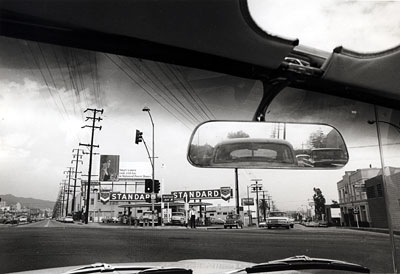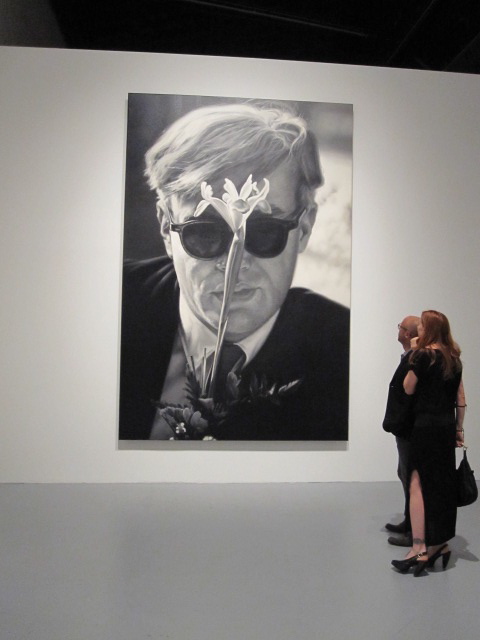In the underrated classic Los Angeles film L.A. Story, Steve Martin fails to get a reservation at L'Idiot, a fictional hot L.A. restaurant with a line out the door and a ticker tape reading the income level and importance of each dinner guest and paparazzi at entry and exit. As Martin and his dinner guest leave, paparazzi back away, screaming, "Never mind! They're nobodies!"
At the Geffen Contemporary at MOCA, the opening of "Dennis Hopper: Double Standard" felt more like a cinematic tribute to Los Angeles stereotypes than a serious exhibition. Before passing away at the age of 74 due to complications from prostate cancer, Dennis Hopper had an uneven career in art, mostly dedicated to imitating his slightly older artist friends. But at the opening, it didn't seem to matter.
The opening was much more exciting than the show itself. Curated by Julian Schnabel, the exhibition drew an eclectic crowd from all corners of the city, everyone obsessed with the scene moreso than with Hopper's art. Wearing gowns of peacock feathers and skintight high-waisted bandage shorts, guests took pictures of people outside, pictures of themselves and pictures inside the gallery. Waiting by the bar, a woman wearing six-inch red high heels whispered to me, "Just to let you know, Diane Keaton and Liv Tyler and the lady who used to be married to Charlie Sheen are inside. Diane Keaton! I almost peed my pants!"
Inside, Diane Keaton was nowhere to be seen. Perhaps she was obscured by the giant fiberglass sculpture of a Mexican waiter looming in the entrance, which might have been a cultural symbol of fear, or stereotypes, or something. Either way, it rang hollow. Hopper began his artistic career with painting in the 1950s. Some early abstract pieces on small canvases show promise, or at least, the promise of promise, which fades later on. Equally unsuccessful works use found objects and graffiti, including an early drawing of a woman with a mustache scribbled above her upper lip. As commentary on femininity and pop culture, it falls flat and graceless.
Hopper was most renowned as a photographer though, and the black-and-white photographs from the 1960s are the best part of the exhibition. In one of the loveliest pictures, a young, golden Jane Fonda wears a bikini and aims a bow and arrow into the distance, full of promise. Other subjects include Robert Rauschenberg, Andy Warhol, Martin Luther King, Jr. and Ike and Tina Turner cheerfully posing with a giant inflatable Coke bottle.
After the year 2000, however, Hopper reproduced some of these earlier photographs to billboard size, with garish results. "I kind of hate this," said one woman, standing next to a giant black and white reproduction of Andy Warhol, who is holding a droopy iris flower and oozing self-importance. The piece seems preoccupied with itself, more like a painting in a Hollywood comedy about the L.A. art scene rather than actual art.

And after looking at the umpteenth photo of Warhol, the title of the show begins to make sense. One wonders, did Hopper's creativity lead to his fame, or was his fame a result of his access to renowned artists and celebrities? Are the two qualities really inseparable from one another? Was Dennis Hopper's artistic fame a double standard? After all, Hopper starred in everything from Easy Rider and Blue Velvet to "classics" like Speed and Super Mario Bros., and dabbled in all types of art, equally embraced for his creative eccentricity as he was exiled for his drug use. But Hopper's cinematic career was more interesting than his artistic one, and as a big survey exhibition, the show sells Los Angeles short. The art scene in the city is much more complicated and intriguing than this exhibition gives it credit for, and MOCA must have access to many more talented artists.
But as the night wore on, no one at the opening seemed to care. The guests stood at tables outside, drinking from clear plastic cups, and everyone watched one woman yelling and dancing to DJ tunes by herself. A plump MOCA photographer leaned against the wall, waiting to capture the L.A. moment.
- By Cassandra McGrath
"Dennis Hopper: Double Standard" is on view at the Geffen Contemporary at MOCA until September 26. For more information, please visit www.moca.org, or call 213-626-6222.
All photographs are courtesy of Cassandra McGrath, as well as the Geffen Contemporary at MOCA.